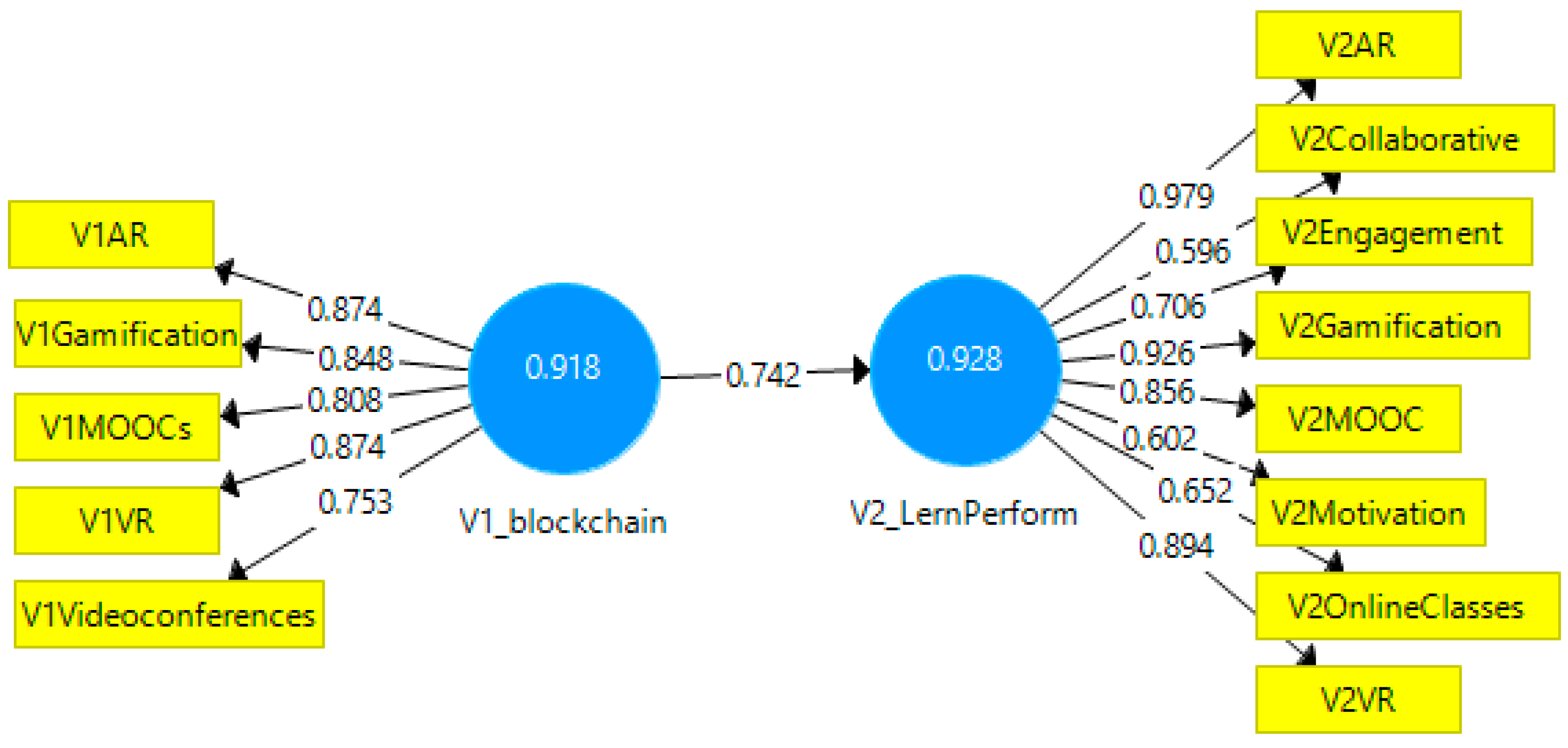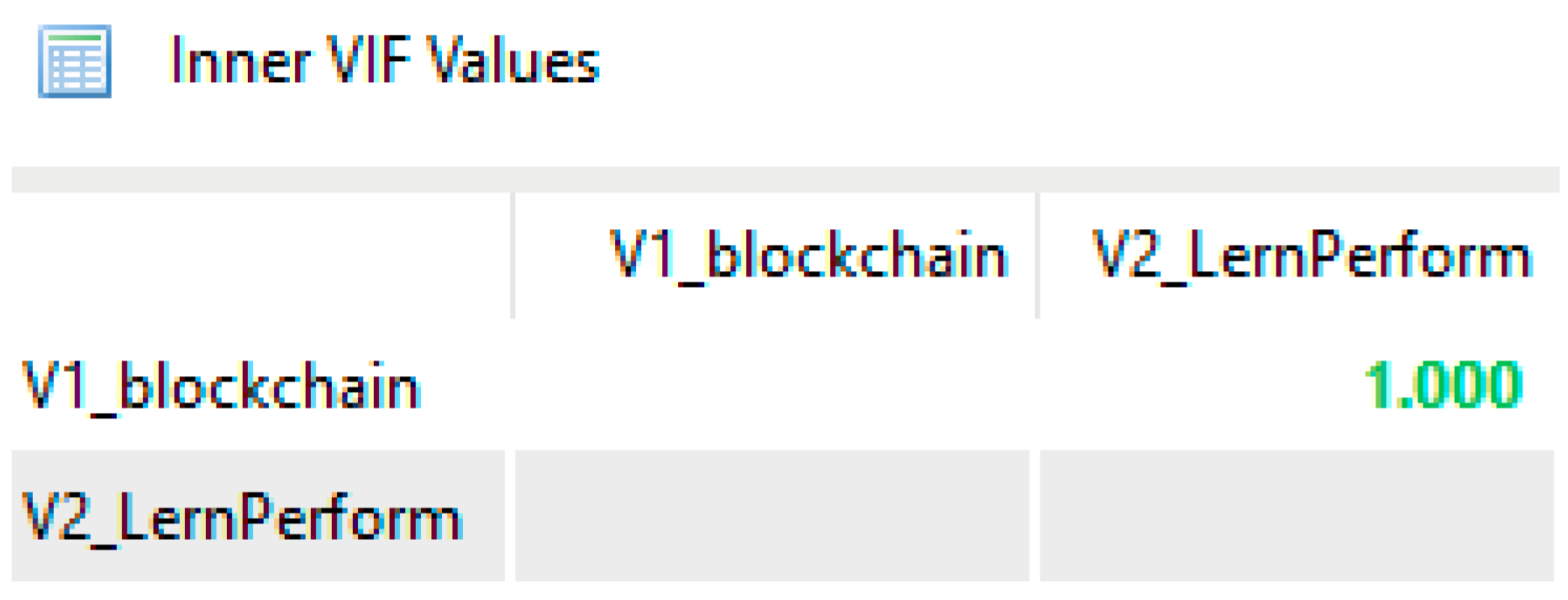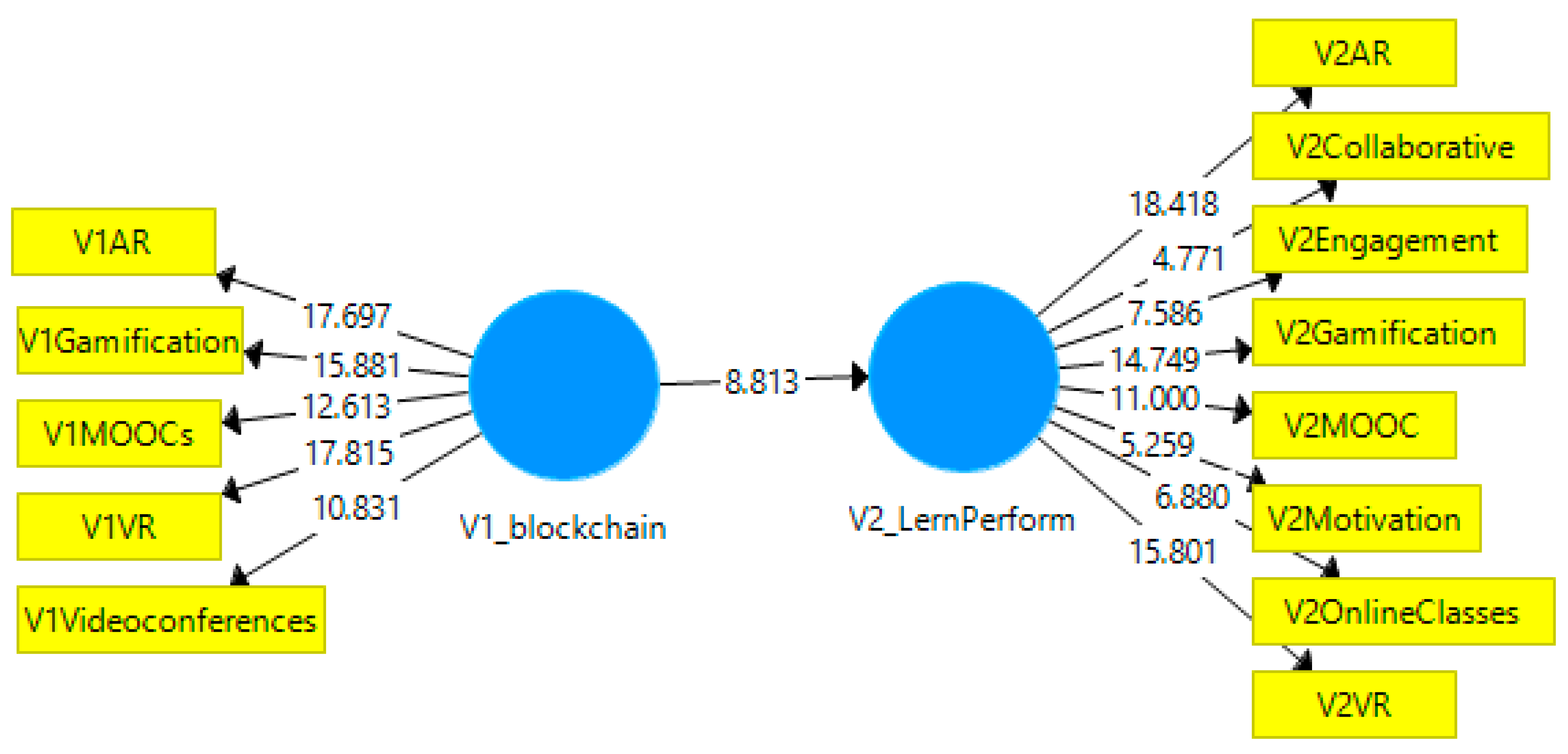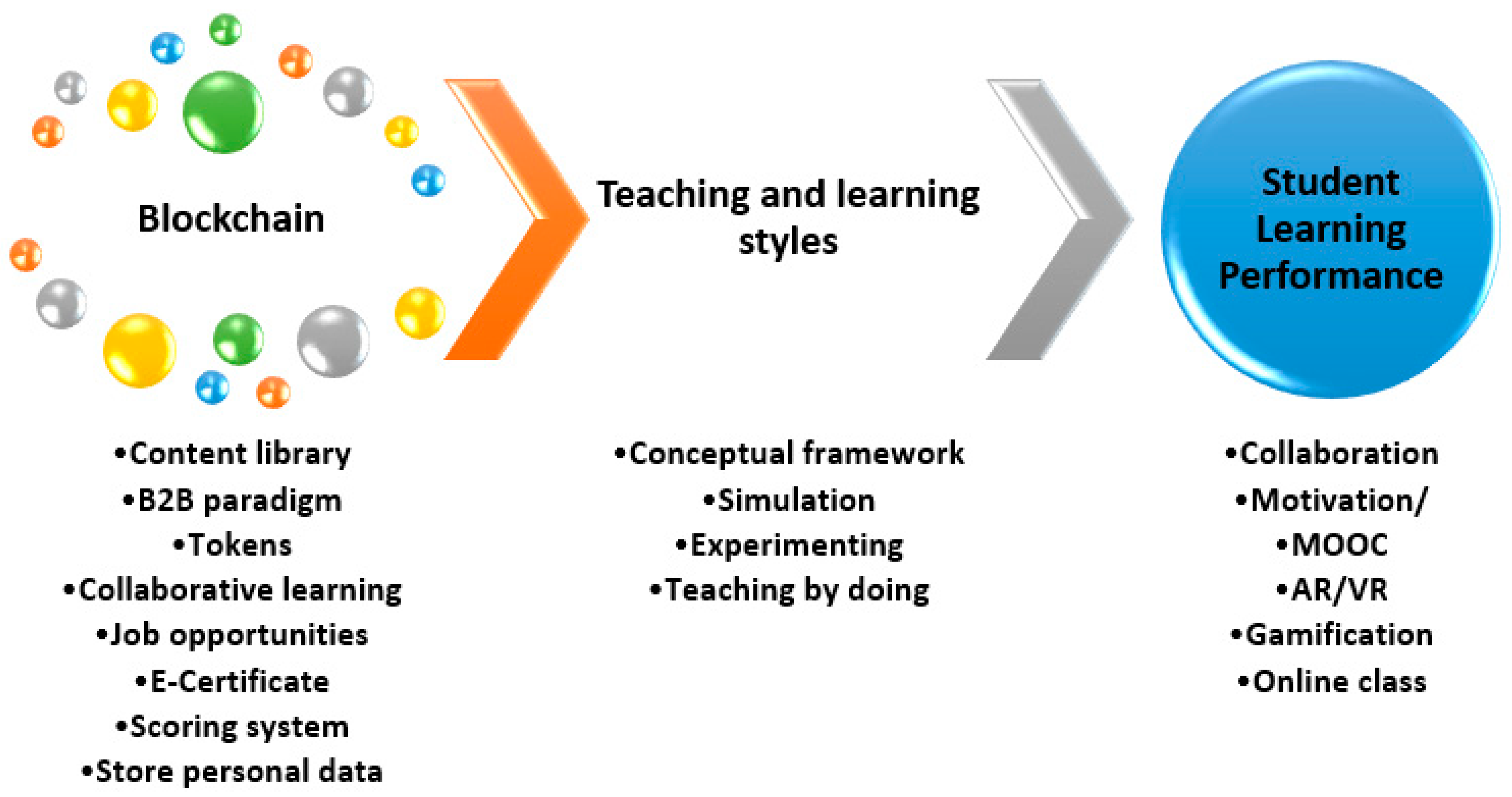The Potential of Blockchain Technology in Higher Education as Perceived by Students in Serbia, Romania, and Portugal
Abstract
:1. Introduction
- What significant opportunities do HEI gain if they implement blockchain technologies?
- What significant challenges do HEI face when they implement blockchain technologies?
2. Literature Review
- A fixed mindset: It is easy to eliminate students from the educational system because they do not meet the criteria. Nevertheless, a better approach will be developed to change the paradigm, mentoring, and guidance to determine necessary student behavior transformation.
- Results-only: The results are significant for sustainability, but we all learn from “trying and making mistakes”. It is advisable to let students experiment in a controlled environment and see the consequences of their tests and behavior. Learning from mistakes sets a strong trace on the neural system and determines a long-time learning effect.
- Elitism: The teacher’s talent might be proven when they can teach for gifted minds, destined for greatness, and for ordinary students, too.
- Self-righteousness: The rules assumed by this research are fundamental in everyday life/education, but there are exceptions when the student faces emotional problems, and the teacher must cope with them.
- Detachment: Detaching from things one fears losing helps to maintain an equilibrium. Some students exhibited desperate gestures when receiving negative feedback from the teacher. Nevertheless, at the same time, rewarding goals maintain student interest and engagement in their struggle to succeed. Detached teachers are mentors who call in each day because they no longer feel connected with their students.
- Lack of nuance: When spending years gaining wisdom, more nuances appear to reach high performance. Being wildly convinced by one idea means that there is a lack of knowledge or perspective.
- Lack of creativity: Prescriptive and rules-bound education ensures a coherent educational system, but sustainable innovation within this system stimulates critical thinking, creativity, communication, collaboration are essential issues.
- Compassion: Students are not robots. They need to be encouraged to step over mental, psychological, emotional, and physical barriers in certain moments.
- Co-creation: The journey and the discovery do not lay out a systematic framework. The teacher may stimulate student interest through inquiry and experimental learning. It does not insist on rigid lesson plans. Sometimes the student can discover their identity and grow in their wisdom.
- Character: The education target should be acquiring a skill set and focusing on the student’s personality. In most educational systems, this mindset is often missing. Some examples of the education system that can make better people are Singapore, Japan, China, etc.
- Perseverance: The students give more significance to the results obtained with struggle than those gained without effort. The student’s attitude must be of sticking with it until they get it right. When students are humble enough to admit they have made a mistake, they can grow.
- Just enough help: Great teachers know when to step out of the way and allow their students to thrive. In this approach, the teacher proved that being a facilitator or a “guide on the side” did not make them less influential but made the teaching more impactful.
- Potential: Teachers can see the potential in students that even the students do not yet believe; they know how to encourage them.
- Simplicity: The great discoveries show that sometimes wisdom is simple, for example, Einstein, who proved gravity. Likewise, proverbs are profound, simple, and reflect reality.
- Mindfulness: The teachers must encourage students to be action-oriented and help them manage their emotions and mind flow in agitated moments.
- Experiential learning: The teachers must create the experiences that allow students to thrive.
- Blockchain is a distributed network of computer systems. Therefore, data breaches are very difficult to carry out.
- Blockchain generates hash codes related to each block. Therefore, it is challenging to implement cyber-attacks.
- Each block’s hash will be modified by manipulating data, and the blockchain becomes invalid.
- Stages of Blockchain implementation are:
- Identifying clear goals and setting priorities for achieving them;
- Making a prototype for implementation and setting a deadline for it;
- Creating an early application and testing it to obtain feedback to correct errors; and
- Launching the application for the public in general and cross-assessment of the results using the benchmark.
3. Materials and Methods
4. Results
4.1. Survey Research: Data and Variables
4.2. Research Process
5. Discussion
6. Conclusions
Author Contributions
Funding
Institutional Review Board Statement
Informed Consent Statement
Data Availability Statement
Conflicts of Interest
References
- Padmavathi, U.; Rajagopalan, N. Concept of Blockchain Technology and Its Emergence. In Blockchain Applications in IoT Security; Patel, H., Thakur, G.S., Eds.; IGI Global: Hershey, PA, USA, 2021; pp. 1–20. [Google Scholar] [CrossRef]
- Fenichel, M.; Schweingruber, H.A. Surrounded by Science: Learning Science in Informal Environments; The National Academic Press: Washington, DC, USA, 2010; p. 78. [Google Scholar]
- Androutsos, A.; Brinia, V. Developing and Piloting a Pedagogy for Teaching Innovation, Collaboration, and Co-Creation in Secondary Education Based on Design Thinking, Digital Transformation, and Entrepreneurship. Educ. Sci. 2019, 9, 113. [Google Scholar] [CrossRef] [Green Version]
- Antonaci, A.; Klemke, R.; Lataster, J.; Kreijns, K.; Specht, M. Gamification of MOOCs adopting social presence and sense of community to increase user’s engagement: An experimental study. In Proceedings of the European Conference on Technology Enhanced Learning: Transforming Learning with Meaningful Technologies, Delft, The Netherlands, 16–19 September 2019; pp. 172–186. [Google Scholar]
- Nakamoto, S. Bitcoin: A peer-to-peer electronic cash system. Decent. Bus. Rev. 2020, 21260. Available online: https://www.ussc.gov/sites/default/files/pdf/training/annual-national-training-seminar/2018/Emerging_Tech_Bitcoin_Crypto.pdf (accessed on 17 December 2021).
- Yang, Q.; Zhang, M.; Zhou, Y.; Wang, T.; Xia, Z.; Yang, B. A Non-Interactive Attribute-Based Access Control Scheme by Blockchain for IoT. Electronics 2021, 10, 1855. [Google Scholar] [CrossRef]
- Edussuriya, C.; Vithanage, K.; Bandara, N.; Alawatugoda, J.; Sandirigama, M.; Jayasinghe, U.; Shone, N.; Lee, G.M. BAT—Block Analytics Tool Integrated with Blockchain Based IoT Platform. Electronics 2020, 9, 1525. [Google Scholar] [CrossRef]
- Oktian, Y.E.; Lee, S.-G.; Lee, H.J. Hierarchical Multi-Blockchain Architecture for Scalable Internet of Things Environment. Electronics 2020, 9, 1050. [Google Scholar] [CrossRef]
- Janjua, K.; Shah, M.A.; Almogren, A.; Khattak, H.A.; Maple, C.; Din, I.U. Proactive Forensics in IoT: Privacy-Aware Log-Preservation Architecture in Fog-Enabled-Cloud Using Holochain and Containerization Technologies. Electronics 2020, 9, 1172. [Google Scholar] [CrossRef]
- Liang, C.; Shanmugam, B.; Azam, S.; Karim, A.; Islam, A.; Zamani, M.; Kavianpour, S.; Idris, N.B. Intrusion Detection System for the Internet of Things Based on Blockchain and Multi-Agent Systems. Electronics 2020, 9, 1120. [Google Scholar] [CrossRef]
- Wang, L.; Xie, Y.; Zhang, D.; Liu, J.; Jiang, S.; Zhang, Y.; Li, M. Credible Peer-to-Peer Trading with Double-Layer Energy Blockchain Network in Distributed Electricity Markets. Electronics 2021, 10, 1815. [Google Scholar] [CrossRef]
- Barka, E.; Dahmane, S.; Kerrache, C.A.; Khayat, M.; Sallabi, F. STHM: A Secured and Trusted Healthcare Monitoring Architecture Using SDN and Blockchain. Electronics 2021, 10, 1787. [Google Scholar] [CrossRef]
- Srinivasu, P.N.; Bhoi, A.K.; Nayak, S.R.; Bhutta, M.R.; Woźniak, M. Blockchain Technology for Secured Healthcare Data Communication among the Non-Terminal Nodes in IoT Architecture in 5G Network. Electronics 2021, 10, 1437. [Google Scholar] [CrossRef]
- Tripathi, G.; Abdul Ahad, M.; Paiva, S. SMS: A Secure Healthcare Model for Smart Cities. Electronics 2020, 9, 1135. [Google Scholar] [CrossRef]
- Girardi, F.; De Gennaro, G.; Colizzi, L.; Convertini, N. Improving the Healthcare Effectiveness: The Possible Role of EHR, IoMT and Blockchain. Electronics 2020, 9, 884. [Google Scholar] [CrossRef]
- Oad, A.; Razaque, A.; Tolemyssov, A.; Alotaibi, M.; Alotaibi, B.; Zhao, C. Blockchain-Enabled Transaction Scanning Method for Money Laundering Detection. Electronics 2021, 10, 1766. [Google Scholar] [CrossRef]
- Yuan, M.; Li, X.; Li, X.; Tan, H.; Xu, J. Trust Hardware Based Secured Privacy Preserving Computation System for Three-Dimensional Data. Electronics 2021, 10, 1546. [Google Scholar] [CrossRef]
- Joshi, G.P.; Perumal, E.; Shankar, K.; Tariq, U.; Ahmad, T.; Ibrahim, A. Toward Blockchain-Enabled Privacy-Preserving Data Transmission in Cluster-Based Vehicular Networks. Electronics 2020, 9, 1358. [Google Scholar] [CrossRef]
- Ra, G.; Seo, D.; Bhuiyan, M.Z.A.; Lee, I. An Anonymous Protocol with User Identification and Linking Capabilities for User Privacy in a Permissioned Blockchain. Electronics 2020, 9, 1183. [Google Scholar] [CrossRef]
- George, S.A.; Stephen, S.M.; Jaekel, A. Blockchain-Based Pseudonym Management Scheme for Vehicular Communication. Electronics 2021, 10, 1584. [Google Scholar] [CrossRef]
- Lei, F.; Cheng, J.; Yang, Y.; Tang, X.; Sheng, V.S.; Huang, C. Improving Heterogeneous Network Knowledge Transfer Based on the Principle of Generative Adversarial. Electronics 2021, 10, 1525. [Google Scholar] [CrossRef]
- Lee, N.-Y.; Yang, J.; Kim, C.-S. Blockchain-Based Smart Propertization of Digital Content for Intellectual Rights Protection. Electronics 2021, 10, 1387. [Google Scholar] [CrossRef]
- Xie, X.; Hu, Z.; Chen, M.; Zhao, Y.; Bai, Y. An Active and Passive Reputation Method for Secure Wideband Spectrum Sensing Based on Blockchain. Electronics 2021, 10, 1346. [Google Scholar] [CrossRef]
- Shrestha, R.; Nam, S.Y.; Bajracharya, R.; Kim, S. Evolution of V2X Communication and Integration of Blockchain for Security Enhancements. Electronics 2020, 9, 1338. [Google Scholar] [CrossRef]
- Huh, J.-H.; Kim, S.-K. Verification Plan Using Neural Algorithm Blockchain Smart Contract for Secure P2P Real Estate Transactions. Electronics 2020, 9, 1052. [Google Scholar] [CrossRef]
- Abbas, K.; Afaq, M.; Ahmed Khan, T.; Song, W.-C. A Blockchain and Machine Learning-Based Drug Supply Chain Management and Recommendation System for Smart Pharmaceutical Industry. Electronics 2020, 9, 852. [Google Scholar] [CrossRef]
- Li, Z.; Liu, J.; Hao, J.; Wang, H.; Xian, M. CrowdSFL: A Secure Crowd Computing Framework Based on Blockchain and Federated Learning. Electronics 2020, 9, 773. [Google Scholar] [CrossRef]
- Alzahrani, B.; Bahaitham, H.; Andejany, M.; Elshennawy, A. How Ready Is Higher Education for Quality 4.0 Transformation according to the LNS Research Framework? Sustainability 2021, 13, 5169. [Google Scholar] [CrossRef]
- Ullah, N.; Mugahed Al-Rahmi, W.; Alzahrani, A.I.; Alfarraj, O.; Alblehai, F.M. Blockchain Technology Adoption in Smart Learning Environments. Sustainability 2021, 13, 1801. [Google Scholar] [CrossRef]
- Wu, T.; Chang, M. The application framework of blockchain technology in higher education based on the smart contract. In Proceedings of the 3rd International Conference on High Performance Big Data and Intelligent Systems, (HPBD&IS 2021), Macau, China, 5–8 December 2021. [Google Scholar]
- Awaji, B.; Solaiman, E.; Albshri, A. Blockchain-based applications in higher education: A systematic mapping study. In Proceedings of the 5th International Conference on Information and Education Innovations (ICIEI 2020), London, UK, 26–28 July 2020; pp. 96–104. [Google Scholar]
- Hoosain, M.S.; Paul, B.S.; Ramakrishna, S. The Impact of 4IR Digital Technologies and Circular Thinking on the United Nations Sustainable Development Goals. Sustainability 2020, 12, 10143. [Google Scholar] [CrossRef]
- Yli-Huumo, J.; Ko, D.; Choi, S.; Park, S.; Smolander, K. Where is current research on blockchain technology?—A systematic review. PLoS ONE 2016, 11, e0163477. [Google Scholar] [CrossRef]
- Tapscott, D.; Tapscott, A. Blockchain Revolution: How the Technology behind Bitcoin Is Changing Money, Business, and the World; Penguin Random House: New York, NY, USA, 2016. [Google Scholar]
- Fedorova, E.P.; Skobleva, E.I. Application of Blockchain Technology in Higher Education. Eur. J. Contemp. Educ. 2020, 9, 552–571. [Google Scholar]
- Khan, A.A.; Laghari, A.A.; Shaikh, A.A.; Bourouis, S.; Mamlouk, A.M.; Alshazly, H. Educational Blockchain: A Secure Degree Attestation and Verification Traceability Architecture for Higher Education Commission. Appl. Sci. 2021, 11, 10917. [Google Scholar] [CrossRef]
- Caldarelli, G.; Ellul, J. Trusted Academic Transcripts on the Blockchain: A Systematic Literature Review. Appl. Sci. 2021, 11, 1842. [Google Scholar] [CrossRef]
- Mahamatov, N.; Kuvnakov, A.; Yokubov, B. Application of Blockchain Technology in Higher Education. In Proceedings of the 2020 International Conference on Information Science and Communications Technologies (ICISCT), Karachi, Pakistan, 8–9 February 2020; pp. 1–6. [Google Scholar]
- Castro, R.Q.; Au-Yong-Oliveira, M. Blockchain and Higher Education Diplomas. Eur. J. Investig. Health Psychol. Educ. 2021, 11, 154–167. [Google Scholar] [CrossRef]
- Guo, J.; Li, C.; Zhang, G.; Sun, Y.; Bie, R. Blockchain-enabled digital rights management for multimedia resources of online education. Multimed. Tools Appl. 2019, 79, 9735–9755. Available online: https://link.springer.com/article/10.1007/s11042-019-08059-1 (accessed on 26 August 2021). [CrossRef]
- Capece, G.; Levialdi Ghiron, N.; Pasquale, F. Blockchain Technology: Redefining Trust for Digital Certificates. Sustainability 2020, 12, 8952. [Google Scholar] [CrossRef]
- Raimundo, R.; Rosário, A. Blockchain System in the Higher Education. Eur. J. Investig. Health Psychol. Educ. 2021, 11, 276–293. [Google Scholar] [CrossRef] [PubMed]
- Bucea-Manea-Țoniş, R.; Martins, O.; Bucea-Manea-Țoniş, R.; Gheorghiță, C.; Kuleto, V.; Ilić, M.P.; Simion, V.E. Blockchain Technology Enhances Sustainable Higher Education. Sustainability 2021, 13, 12347. [Google Scholar] [CrossRef]
- Nakamoto, S. Bitcoin: A Peer-to-Peer Electronic Cash System; White Paper. 2008. Available online: https://git.dhimmel.com/bitcoin-whitepaper/ (accessed on 18 August 2021).
- Truong, N.B.; Um, T.W.; Zhou, B.; Lee, G.M. Strengthening the blockchain-based internet of value with trust. In Proceedings of the 2018 IEEE International Conference on Communications (ICC), Kansas City, MO, USA, 20–24 May 2018; pp. 1–7. [Google Scholar]
- Bdiwi, R.; de Runz, C.; Faiz, S.; Cherif, A.A. Towards a new ubiquitous learning environment based on Blockchain technology. In Proceedings of the 2017 IEEE 17th International Conference on Advanced Learning Technologies (ICALT), Timisoara, Romania, 3–7 July 2017; pp. 101–102. [Google Scholar]
- Abad-Segura, E.; González-Zamar, M.D.; Infante-Moro, J.C.; García, G.P.R. Sustainable Management of Digital Transformation in Higher Education: Global Research Trends. Sustainability 2020, 12, 2107. [Google Scholar] [CrossRef] [Green Version]
- Caldarelli, G.; Ellul, J. The Blockchain Oracle Problem in Decentralized Finance—A Multivocal Approach. Appl. Sci. 2021, 11, 7572. [Google Scholar] [CrossRef]
- Bucea-Manea-Tonis, R.; Gurgu, E.; Martins, O.M.D.; Simion, V.E. An Overview of How VR/AR Applications Assist Specialists in Developing Better Consumer Behavior and Can Revolutionise Our Life. In Consumer Happiness Multiple Perspectives; Springer: Singapore, 2021; pp. 231–253. [Google Scholar]
- Bidarra, J.; Coelho, J. Once upon a tip… a story of MOOCs and Gamification. In Proceedings of the EADTU Conference 2017: The Open and Flexible Higher Education Conference, Milton Keynes, UK, 25–27 October 2017. [Google Scholar]
- Antonaci, A.; Klemke, R.; Stracke, C.M.; Specht, M. Identifying game elements suitable for MOOCs. In Proceedings of the European Conference on Technology Enhanced Learning (EC-TEL 2017), Tallinn, Estonia, 12–15 September 2017; Springer: Cham, Switzerland, 2017; pp. 355–360. [Google Scholar]
- Imoize, A.L.; Adedeji, O.; Tandiya, N.; Shetty, S. 6G Enabled Smart Infrastructure for Sustainable Society: Opportunities, Challenges, and Research Roadmap. Sensors 2021, 21, 1709. [Google Scholar] [CrossRef]
- Frizzo-Barker, J.; Chow-White, P.A.; Adams, P.R.; Mentanko, J.; Ha, D.; Green, S. Blockchain as a disruptive technology for business: A systematic review. Int. J. Inf. Manag. 2020, 51, 102029. [Google Scholar] [CrossRef]
- Brrás-Gené, O.; Martínez-Núñez, M.; Fidalgo-Blanco, Á. New challenges for the motivation and learning in engineering education using gamification in MOOC. Int. J. Eng. Educ. 2015, 32, 501–512. Available online: https://repositorio.grial.eu/bitstream/grial/560/1/19_ijee3155ns.pdf (accessed on 17 December 2021).
- Brouns, F.; Mota, J.; Morgado, L.; Jansen, D.; Fano, S.; Silva, A.; Teixeira, A. A networked learning framework for effective MOOC design: The ECO project approach. In Proceedings of the 8th EDEN Research Workshop: Challenges for Research into Open & Distance Learning: Doing Things Better: Doing Better Things, Oxford, UK, 27–28 October 2014; The European Distance and E-Learning Network (EDEN): Budapest, Hungary, 2014; pp. 161–171. Available online: https://oszkdk.oszk.hu/storage/00/01/62/98/dd/1/RW_2014_Oxford_Proceedings_NAP.pdf#page=173 (accessed on 26 August 2021).
- Science Museum; AgriTechCentre of Excellence; University of Adelaide; The Holy Quran Academy. Available online: https://www.igloovision.com/case-studies (accessed on 26 August 2021).
- Online Course Platforms—MOOC. Available online: https://www.bestcolleges.com/blog/platforms-for-online-courses/ (accessed on 26 August 2021).
- Steiu, M.F. Blockchain in education: Opportunities, applications, and challenges. First Monday 2020, 25. [Google Scholar] [CrossRef]
- Reis-Marques, C.; Figueiredo, R.; de Castro Neto, M. Applications of Blockchain Technology to Higher Education Arena: A Bibliometric Analysis. Eur. J. Investig. Health Psychol. Educ. 2021, 11, 1406–1421. [Google Scholar] [CrossRef]
- Widayanti, R.; Purnama Harahap, E.; Lutfiani, N.; Putri Oganda, F.; Manik, I.S.P. The Impact of Blockchain Technology in Higher Education Quality Improvement. J. Ilm. Tek. Elektro Komput. Dan Inform. 2021, 7, 207–216. [Google Scholar] [CrossRef]
- Gotz, O.; Liehr-Gobbers, K.; Krafft, M. Evaluation of Structural Equation Models Using the Partial Least Squares (PLS) Approach. In Handbook of Partial Least Squares: Concepts, Methods and Applications, 1st ed.; Esposito Vinzi, V., Chin, W.W., Henseler, J., Wang, H., Eds.; Springer: Cham, Switzerland, 2010; pp. 691–712. ISBN 978-3-540-32825-4. [Google Scholar] [CrossRef]
- Hair, J.F.; Risher, J.J.; Sarstedt, M.; Ringle, C.M. When to use and how to report the results of PLS-SEM. Eur. Bus. Rev. 2019, 31, 2–24. [Google Scholar] [CrossRef]
- Kuleto, V.; Ilić, M.; Dumangiu, M.; Ranković, M.; Martins, O.M.D.; Păun, D.; Mihoreanu, L. Exploring Opportunities and Challenges of Artificial Intelligence and Machine Learning in Higher Education Institutions. Sustainability 2021, 13, 10424. [Google Scholar] [CrossRef]





| Conceptual framework | Methods | |||
| Virtual reality [VR] and augmented reality [AR] were considered scientific tools that help the learning process in different fields [49]. | Massive online open courses [MOOCs] were seen to engage and motivate massive audiences, especially those related to dropping out of school [4]. There are strategies, such as social networking and digital storytelling, to ensure open education [50]. | An application of game design, in non-game scenarios, to solve problems or change the behavior [51]. It was also considered as a critical pedagogical tool to improve student motivation [50] In addition, gamification design impacts users’ development and learning performance of users [4] | Videoconferences | |
| Simulation | X | X | X | |
| Experimenting | X | X | X | |
| Teaching by doing | X | X | ||
| Platform Services | Tutellus | SGE | Edgecoin | |||
|---|---|---|---|---|---|---|
| Content library | x | An excellent platform for online educational collaboration. Initially for Spanish-speaking countries, from 2019 available in other languages | X | Integrated platform to support the educational system | x | The world’s first Educational Stable Coin offers an open payment system for educational institutions. Associated with the stable coin, the platform offers “Gradecoin”, a fluctuating coin that allows students to “earn while they learn.” |
| B2B paradigm | x | X | x | |||
| Tokens | x | x | ||||
| Collaborative learning | x | x | ||||
| Job opportunities | X | Integrated platform to support an educational system | ||||
| E-Certificate | X | x | ||||
| Scoring system | X | |||||
| Store personal data | X | x | ||||
| HEI | Courses | Results |
|---|---|---|
| Technical University of Madrid, Spain [54] | Engineering education, Information and Communication Technologies | The incorporation of virtual methodologies improved the learning process and the motivation of students in engineering MOOCs |
| Universidade Aberta [50] | Aula aberta em 2013 | Gamification, as well as other innovative strategies (e.g., digital storytelling), can help the sustainability of HE at institutions such as the Aberta University |
| Open University e EADTU (Holanda), Universidade Aberta (Portugal), Universidad de Oviedo (Spain), Universidade de Zaragoza (Spain) [55] | Integrated into the ECO European project | ECO MOOCs, massive, open, and online courses |
| Science Museum, AgriTech Centre of Excellence, University of Adelaide, The Holy Quran Academy [56] | VR/AR | The use of technology in schools, in the field of education, provides the students with unlimited learning and development opportunities |
| Online Course Platforms—MOOCs [57]; | Canvas Network, Coursera, FutureLearn, Cognitive Class | Provides predominantly free and self-paced online classes; users can pursue coursework at their own pace with no time restrictions for completion; addresses information from different fields; low-cost online academic programs |
| Variable Name | Code of Indicator | Indicator Name |
|---|---|---|
| Student Learning Performance | V2 Collaborative | V2 Collaborative work enhances learning performance |
| V2 Motivation | V2 Motivation enhances learning performance | |
| V2 Engagement | V2 Engagement enhances learning performance | |
| V2 MOOCs | V2 MOOCs enhances learning performance | |
| V2 AR | V2 AR enhances learning performance | |
| V2 VR | V2 VR enhances learning performance | |
| V2 Gamification | V2 Gamification enhances learning performance | |
| V2 Online class | V2 Online classes enhance learning performance | |
| Blockchain | V1 MOOCs | V1—Blockchain is used in HE for the massive audience [MOOCs] |
| V1 AR | V1—Blockchain is used in HE for the massive audience [AR] | |
| V1 VR | V1—Blockchain is used in HE for the massive audience [VR] | |
| V1 Gamification | V1—Blockchain is used in HE for the massive audience [Gamification] | |
| V1Videoconferences | V1—Blockchain is used in HE for the massive audience. [Videoconferences] |
| Reflexive Construct | Composite Reliability | Cronbach’s Alpha | AVE | R Square |
|---|---|---|---|---|
| (>0.7) | (>0.7) | (>0.5) | (>0.5) | |
| V1Blockchain | 0.918 | 0.934 | 0.624 | |
| V2LernPerform | 0.928 | 0.918 | 0.703 | 0.551 |
Publisher’s Note: MDPI stays neutral with regard to jurisdictional claims in published maps and institutional affiliations. |
© 2022 by the authors. Licensee MDPI, Basel, Switzerland. This article is an open access article distributed under the terms and conditions of the Creative Commons Attribution (CC BY) license (https://creativecommons.org/licenses/by/4.0/).
Share and Cite
Kuleto, V.; Bucea-Manea-Țoniş, R.; Bucea-Manea-Țoniş, R.; Ilić, M.P.; Martins, O.M.D.; Ranković, M.; Coelho, A.S. The Potential of Blockchain Technology in Higher Education as Perceived by Students in Serbia, Romania, and Portugal. Sustainability 2022, 14, 749. https://doi.org/10.3390/su14020749
Kuleto V, Bucea-Manea-Țoniş R, Bucea-Manea-Țoniş R, Ilić MP, Martins OMD, Ranković M, Coelho AS. The Potential of Blockchain Technology in Higher Education as Perceived by Students in Serbia, Romania, and Portugal. Sustainability. 2022; 14(2):749. https://doi.org/10.3390/su14020749
Chicago/Turabian StyleKuleto, Valentin, Rocsana Bucea-Manea-Țoniş, Radu Bucea-Manea-Țoniş, Milena P. Ilić, Oliva M. D. Martins, Marko Ranković, and Ana Sofia Coelho. 2022. "The Potential of Blockchain Technology in Higher Education as Perceived by Students in Serbia, Romania, and Portugal" Sustainability 14, no. 2: 749. https://doi.org/10.3390/su14020749
APA StyleKuleto, V., Bucea-Manea-Țoniş, R., Bucea-Manea-Țoniş, R., Ilić, M. P., Martins, O. M. D., Ranković, M., & Coelho, A. S. (2022). The Potential of Blockchain Technology in Higher Education as Perceived by Students in Serbia, Romania, and Portugal. Sustainability, 14(2), 749. https://doi.org/10.3390/su14020749










